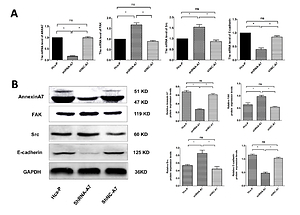Current issue
Archive
Manuscripts accepted
About the Journal
Editorial office
Editorial board
Section Editors
Abstracting and indexing
Subscription
Contact
Ethical standards and procedures
Most read articles
Instructions for authors
Article Processing Charge (APC)
Regulations of paying article processing charge (APC)
ONCOLOGY / RESEARCH PAPER
AnnexinA7 and CAP1 are associated with regulating tumor cell adhesion molecule expression and biological behavior
1
Guizhou Medical University, China
2
Guizhou Medical University Affiliated Hospital, China
3
Dalian Medical University, China
Submission date: 2020-05-31
Final revision date: 2020-12-20
Acceptance date: 2020-12-26
Online publication date: 2021-03-26
KEYWORDS
TOPICS
ABSTRACT
Introduction:
To find out the correlations between the effects of down-regulating AnnexinA7 and CAP1 gene on cell adhesion factors and the biological behavior of Hca-p cells cells, and finally infer the relationship between the two genes.
Material and methods:
Western blot ,qRT-PCR,immunocytochemistry, CCK8 cell proliferation, flow cytometry, lymph node adhesion and transwell chamber assay testing .
Results:
AnnexinA7 and CAP1 were consistent with the regulation of the expression of the adhesion molecules such as FAK, Src, Paxillin and E-cadherin. At the mRNA and protein levels, the expression of FAK, Src and Paxillin were increased with down-regulated AnnexinA7 and CAP1 genes, while E-cadherin was down-regulated in the change of these two genes. And the low expression of AnnexinA7 could affect the expression of CAP1 in mRNA and protein levels. otherwise, the localization of AnnexinA7 and CAP1 in hepatocellular carcinoma cells was also the same. After down-regulating the expression of CAP1, the functions of proliferation, lymph node adhesion and invasion were increased and early apoptotic ability was decreased in Hca-P cells.
Conclusions:
AnnexinA7 and CAP1 could control the expression of these adhesion molecules in the same trend. We speculated they may be co-localization. And AnnexinA7 gene may be related to the molecular mechanism of CAP1 gene, which is likely to have a consistent effect on cell adhesion molecules and be closely related to the biological behaviors of Hca-P cells.AnnexinA7 and CAP1 may play an inhibitory role in lymph node metastasis to provide a reliable basis for the early identification of lymphatic metastasis in hepatocellular carcinoma.
To find out the correlations between the effects of down-regulating AnnexinA7 and CAP1 gene on cell adhesion factors and the biological behavior of Hca-p cells cells, and finally infer the relationship between the two genes.
Material and methods:
Western blot ,qRT-PCR,immunocytochemistry, CCK8 cell proliferation, flow cytometry, lymph node adhesion and transwell chamber assay testing .
Results:
AnnexinA7 and CAP1 were consistent with the regulation of the expression of the adhesion molecules such as FAK, Src, Paxillin and E-cadherin. At the mRNA and protein levels, the expression of FAK, Src and Paxillin were increased with down-regulated AnnexinA7 and CAP1 genes, while E-cadherin was down-regulated in the change of these two genes. And the low expression of AnnexinA7 could affect the expression of CAP1 in mRNA and protein levels. otherwise, the localization of AnnexinA7 and CAP1 in hepatocellular carcinoma cells was also the same. After down-regulating the expression of CAP1, the functions of proliferation, lymph node adhesion and invasion were increased and early apoptotic ability was decreased in Hca-P cells.
Conclusions:
AnnexinA7 and CAP1 could control the expression of these adhesion molecules in the same trend. We speculated they may be co-localization. And AnnexinA7 gene may be related to the molecular mechanism of CAP1 gene, which is likely to have a consistent effect on cell adhesion molecules and be closely related to the biological behaviors of Hca-P cells.AnnexinA7 and CAP1 may play an inhibitory role in lymph node metastasis to provide a reliable basis for the early identification of lymphatic metastasis in hepatocellular carcinoma.
Share
RELATED ARTICLE
We process personal data collected when visiting the website. The function of obtaining information about users and their behavior is carried out by voluntarily entered information in forms and saving cookies in end devices. Data, including cookies, are used to provide services, improve the user experience and to analyze the traffic in accordance with the Privacy policy. Data are also collected and processed by Google Analytics tool (more).
You can change cookies settings in your browser. Restricted use of cookies in the browser configuration may affect some functionalities of the website.
You can change cookies settings in your browser. Restricted use of cookies in the browser configuration may affect some functionalities of the website.



